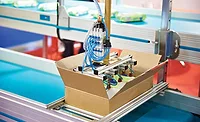Food Safety
Food defense has become a critical aspect of food safety audits

Receiving programs now include food defense, with dock workers trained to look for damage that could indicate tampering.
Photo courtesy of Getty Images
Food defense is now an integral element in almost all third-party audit schemes, in particular ones from the Global Food Safety Initiative (GFSI).
The International Organization for Standardization (ISO) includes food defense, biovigilance and bioterrorism in its technical standard TS 22002-1. This standard evolved from the PAS (Publicly Available Specification) 220 document, developed by the British Standards Institution to augment the ISO 22000 food safety standard.
The importance of food defense to the industry is underscored by the fact that both the USDA and the FDA have developed food defense self-assessment tools. The documents are excellent resources that any processor, large or small, may use to evaluate its commitment to food defense.
Ideally, the assessment should be done by the in-house person assigned to manage the food defense program. If a section is not applicable to your operation, simply don’t fill it out.
The person conducting the assessment should have food defense training, either online or in a classroom situation. The classroom option is probably more valuable because people have the opportunity to easily ask questions and discuss ideas with others.
All food processors should understand that building a well-documented food safety management program will help ensure a good start on building a food defense system. Many food safety elements should be incorporated into the food defense program.
Processors will need to assess whether the protocols developed as part of the food safety management system properly address food defense issues.
Looking for quick answers on food safety topics?
Try Ask FSM, our new smart AI search tool.
Ask FSM →
The following are basic elements of a food safety management system that can be incorporated into a processor’s food defense program:
- Sign-in and sign-out procedures for visitors, informing them of plant regulations and requiring proper identification
- Receiving programs, including bulk receiving
- Shipping programs
- Barriers to the plant and grounds that prevent unauthorized access
- Programs for truckers and contractors
- Water supply protection measures
- Protection of stored ingredients, including bulk containers
- Use of tamper-evident packaging
- Protection and handling procedures for chemicals
- Employee sign-in or check-in programs
- Provisions for employee background checks
- Internal audit programs
- Use of closed-circuit television
- Training of all workers
Let’s look at some of the procedures and examine how they apply to safety and defense.
Food processors must monitor persons entering and leaving their plants and/or the grounds. Visitors, contractors and truckers need to sign in and sign out.
Part of the sign-in process is to make sure that these persons are made aware of plant rules governing food safety, sanitation and food defense. In most plants, an employee must accompany visitors. This helps ensure that foods, ingredients and packaging are protected from contamination, adulteration or acts of bioterrorism.
In other words, the procedures are part of biovigilance.
The expectation is that all food processors will have documented programs for receiving ingredients, raw materials and packaging. Receiving programs are usually designed to ensure that the proper items are delivered and are in good condition. They also ensure that the delivery vehicle itself is in good condition—clean, pest-free and free of strange odors.
Processors have expanded receiving programs to incorporate food defense.
Persons working at the receiving docks are now being trained to look for damage that could indicate tampering or spills of suspicious materials. One company with which I worked many years back rejected a rail car that had been sealed because there was a white powder on the car’s floor.
Programs that companies design for bulk receiving of liquids and powders are now very strict. They mandate that all hatches and outlets be sealed and locked. In addition, many companies mandate that any truck or trailer delivering foods or ingredients be from a dedicated food hauler with evidence of past deliveries.
Trailers hauling bulk liquids must provide wash tags when making deliveries, indicating the type of wash done and preferably showing that the washing facility is certified by a third party.
If a seal or lock is not secure, the load will be rejected. Why? There is a concern that the load may have been compromised.
Tamper-evident packaging may be employed for a number of reasons, including food quality, food safety and food defense to ensure no tampering has occurred. There are many different types of tamper-evident systems, ranging from stretch wrap to tape used on individual cases.
Many companies mandate that their ingredient suppliers package their products in tamper-evident packaging. This is probably most important when receiving goods via LTL (less than truckload) shipments because they come in vehicles that carry many other items and make multiple stops.
Programs to ensure water quality are another aspect of food safety that crosses into a company’s food defense program. Water can have many different uses in a food plant, depending upon the products being manufactured. It can be an ingredient that requires pretreatment, or it can be used for cleaning and sanitizing or as a source for culinary steam, which means it will be treated with chemicals and filtered.
As part of the water quality program, plants should have up-to-date plumbing diagrams that clearly delineate lines for fresh water, waste water and sewage. Diagrams also may include steam and treated water locations. Plants source water from municipal water districts, wells or local water sources, which means that they must treat water on-site.
Food defense has become integrated into the program when dealing with water mains or well heads because most food plants now ensure that they are secured. They are enclosed with fencing that may be topped with barbed or razor wire. Access points to mains or well heads are locked and accessible only to authorized personnel. A closed-circuit camera system may be locked onto the area.
This brings us to the last point of discussion: closed-circuit television or CCTV. Food plants have used cameras for many years, but usage has increased with the emphasis on food defense. In the past, the cameras may have focused on parking lots to help ensure worker safety or on loading docks to monitor shipping and receiving.
Today, companies have expanded their systems to monitor many more sites, including areas that the food defense assessment has identified as high risk. Companies also might monitor water lines coming into the plant, and those receiving bulk liquids or solids often arrange cameras to track receiving and unloading. The goal is not only food safety but also food defense, or protecting product from tampering or adulteration.
To make all this work, processors need a trained and committed workforce. Food defense has become an integral element of orientation programs for new employees and refresher sessions for current staff.
The individual worker’s role is to be vigilant. If employees see something or someone out of the ordinary, they need to let their supervisors know. Food safety and food defense are everyone’s responsibility.









